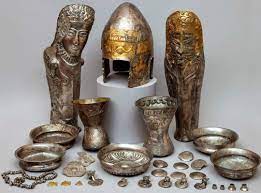In the summer of 1970, an extraordinary discovery was made in the southeast of Peretu commune, Romania. While farmers were plowing the fields, they unearthed a tomb belonging to a royal figure from the late 4th century BC. This accidental find led to extensive archaeological excavations, revealing a treasure trove of artifacts and shedding light on the rich history of the Geto-Dacian people.
Unearthing the Past

As archaeologists delved into the tomb, they uncovered the skeleton of a man, alongside the head and legs of a horse, the remains of two dogs, and a Bovidae. The tomb also contained an array of Getic ceramic vessels, iron weapons, and parts of an iron hearse equipped with four wheels. These items were just the beginning of the remarkable inventory found within the tomb.
Treasures of Silver, Bronze, and Copper

The excavation revealed a wealth of objects made from silver, bronze, and copper. Among the most notable finds were a helmet or crown, a possible rhyton vessel, an aryballos-type container, three phiale vessels, appliques, buttons, beads, a colander, a tray, and a cauldron. These artifacts provided a glimpse into the opulence and craftsmanship of the Geto-Dacian royalty.
The Enigmatic Rhyton

One of the most intriguing discoveries was a silver and gold head, believed by many historians and archaeologists to be a rhyton of a female persona. However, there is some debate about its purpose and representation. Typically, rhytons were used for ritual or celebratory purposes, and drinking from this vessel would display the face upside-down, which is unusual for ceremonial art.
Small holes in the neck of the head suggest it may have been fastened to a staff, adding to the mystery of its function. The question arises: was the character represented by the rhyton a man or a woman? If the scepter indicates a man, the head could represent the astral deity Apollo, adored by the Geto-Dacian and Thracian kings. On the other hand, if the head represents a female, it could be the Geto-Dacian goddess Bendis, who, along with Apollo, held authority over princes and the scepters of kings.
The Royal Crown
The silver and gold helmet or crown discovered in the tomb is of the Getic type, identical in shape and ornamentation to helmets found in Agighiol and the Iron Gates. This suggests that the crown was worn by a lower class of royals, possibly a family member or a general. The crown’s color, artwork, shape, and size indicated the region of kingship, communicated power, and identified deities during religious or war ceremonies and parades.
Symbolism and Power

The geographic location and design of the crowns discovered in the tomb point to their symbolic significance. The eyes on the crowns are thought to represent Zamolxis, the Geto-Dacian God, or the Throne of God. This symbolism underscores the deep connection between the royal figures and their divine protectors, emphasizing their authority and sacred status.
A Window into Geto-Dacian Culture

The discovery of the Geto-Dacian royal treasure at Peretu commune offers a fascinating window into the culture and traditions of an ancient civilization. The artifacts unearthed from the tomb reveal the intricate artistry and rich symbolism that defined the Geto-Dacian royal class. As historians and archaeologists continue to study these treasures, we gain a deeper understanding of the legacy of the Geto-Dacian people and their place in the tapestry of history.
The Peretu commune discovery serves as a testament to the enduring fascination with ancient cultures and the timeless allure of uncovering the secrets of the past.
